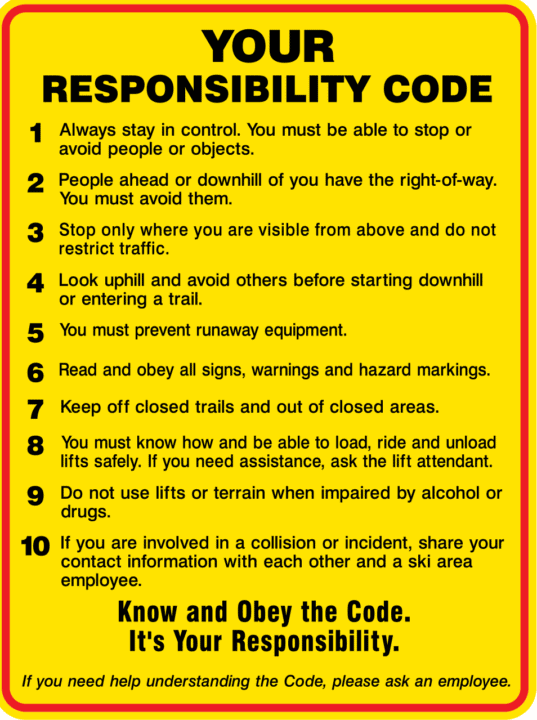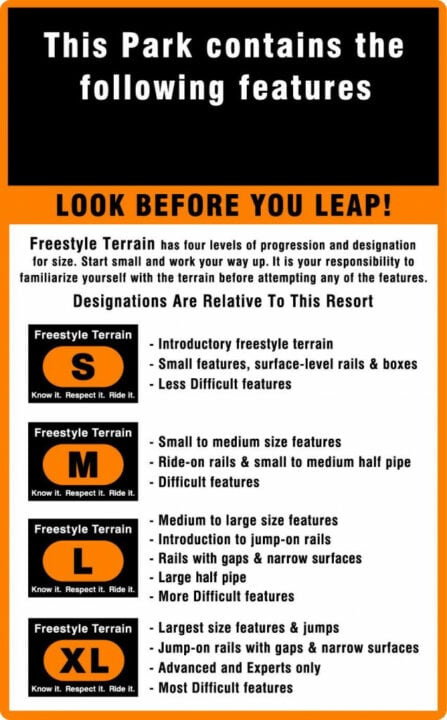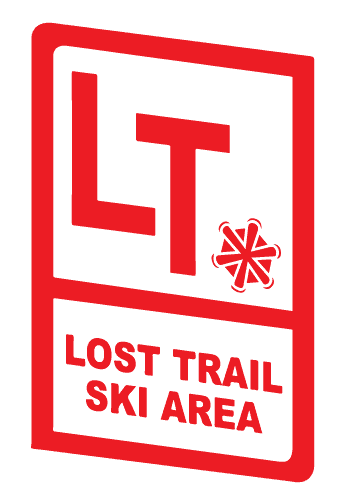Know The Symbols
You’ve arrived. You’re geared up and have a lift ticket. Now what? Go get a trail map at the lodge or lift-ticket window. Take a few minutes to check it out. The lifts and the trails are marked on the map. The colored symbols next to the trails are the keys to enjoying your first few days on the slopes. Their shape and color indicate the difficulty of the trail.
Here’s what they mean:

Visit www.LidsOnKids.org This site dedicated to providing information on helmet safety and answer questions about helmet use.
Helmet use is strongly recommended for all ages.
Prior to Hitting the Slopes
Tips for while on the Slopes
Layer Up
The best way to dress for winter is to wear layers. This gives you flexibility to add or remove layers, depending on the weather and your activity.
Wicking layer: This is the layer worn next to your skin, usually consisting of long underwear.
Insulating layer: The middle layer could include sweaters, sweatshirts, vests and pullovers. This layer is to keep heat in and cold out by insulation. Comfort is key for the insulating layer. It should be loose enough to trap air between layers but not so bulky that it restricts movement. Try to avoid cotton because it retains moisture. Popular insulation materials include:
Protection layer: The exterior layer, generally a shell (coat) and pants, serves as your guard against the elements of winter. It should repel water from snow, sleet or rain and block the wind, while also letting perspiration evaporate. Whether you are a skier or snowboarder, your protection layer should fit comfortably, offering you maximum range of motion.
Headwear: Up to 60 percent of your body’s heat can escape from an uncovered head, so wearing a hat, headband or helmet is essential when it’s cold. Helmets are popular as part of safety equipment. Not only do they protect your head from bumps but they also keep your head warm. A neck gaiter or face mask is a must on cold days and are available for purchase in our retail shop.
Sunglasses and goggles: Sunglasses protect your eyes from damaging solar radiation. Snow, or any other reflective surface, makes ultraviolet (UV) rays stronger, while increased altitude also magnifies the danger. Look for 100 percent UV protection in sunglasses. On flat-light days or when it’s snowing, goggles are vital. They protect your eyes and special lens colors increase the contrast so you can properly identify terrain features. Goggles should form an uninterrupted seal on your face, extending above your eyebrows and below your cheekbones. Watch for gaps, especially around your nose.
Gloves and mittens: Look for waterproof, breathable fabrics. Mittens, in general, are warmer than gloves. Snowboarding gloves and mittens often have a reinforced palm because of extra wear from adjusting bindings and balancing on the snow. Don’t buy gloves or mittens that are too tight. There should be a little air space at the tips of your fingers, which acts as additional insulation.
Socks: Wear one pair of light-weight or medium-weight socks specific for snowsports. Some socks have wicking properties similar to long underwear, meaning your feet will stay dry and comfortable. Avoid cotton because it retains moisture. Resist the temptation of putting on too many pairs of socks.
Lost Trail Ski Area Retail Shop offers a variety of accessories for your last minute needs.
Contact LTSA Ski Patrollers wearing red parkas with white crosses through a lift attendant or other LTSA employees in case of injury or accident on the mountain. Please report the location, type of injury and description of the injured skier.
WHEN CARING FOR AN INJURED PERSON, PLEASE REMEMBER:
Winter sports involve risk of serious injury or death. Your knowledge, decisions and actions contribute to your safety and that of others. If you need help understanding the Code, please ask any ski area employee.
A skier shall accept all legal responsibility for injury or damage of any kind to the extent that the injury or damage results from inherent dangers and risks of skiing. Nothing in this part may be construed to limit a skier’s right to hold another skier legally accountable for damages caused by the other skier.

Venturing into the untouched realms of deep powder snow is an exhilarating experience many skiers and snowboarders crave. Beyond the groomed trails, there’s a sense of freedom and connection with nature that’s hard to beat. But with great adventure comes great responsibility. The off-piste areas present dangers that all winter sport enthusiasts should be aware of and prepared for, primarily the threats of tree wells and deep snow immersions.
Understanding the Risk
When skiing or riding off the groomed runs, you are willingly accepting certain risks, one of which is the potential danger posed by tree wells and deep snow. A tree well is a void or depression that forms around the base of a tree covered by deep snow. When a skier or snowboarder accidentally falls into one, they might find themselves trapped in unconsolidated snow. Panic and struggle can exacerbate the situation, further entrapping the individual. Such incidents, when leading to fatalities, are termed as NARSID or Non-Avalanche Related Snow Immersion Death. While they are grave, with knowledge and caution, they are largely preventable.
Key Safety Tips in Deep Snow & Near Tree Wells:
Remember, the backcountry offers unmatched beauty and thrill, but it’s imperative to respect its power and potential dangers. Stay safe, ski with a buddy, and always prioritize awareness and preparedness. Enjoy the slopes responsibly!

Freestyle Terrain is popular at ski resorts and proper use is important. The National Ski Areas Association and Burton Snowboards have developed the “Smart Style” Freestyle Terrain Safety initiative, a cooperative effort to continue the proper use and progression of freestyle terrain at mountain ski resorts, while also delivering a unified message that is clear, concise and effective.
The 3 main points of Smart Style include:
For more information visit: http://www.freestyleterrain.org/

Whether you’re taking your family out skiing for the first time, racing friends down the mountain, going lone wolf, or getting on the slopes after taking a break, we are committed to keeping skiing and snowboarding affordable and accessible to all. We have a variety of lift tickets, season passes, lessons, and rental options available so you can choose your own adventure.
Get outfitted with boots, boards, poles, and skis at our rental shop. In-person only.
Lift tickets and 10-Day passes are available at the ticketing windows and online.
Start planning out your adventure at Lost Trail by reviewing the map of the area.
Stay in the know for daily powder alerts. Text “POWDER” to
406-625-0585
Level up your skiing and riding this season with Lost Trail Snow Sports School.
Our top credentialed instructors specialize in teaching those brand new to the slopes and those looking to fine-tune their technique.

Lost Trail Ski Area
9485 US Hwy-93 South,
Sula, MT 59871
(406) 821.3211
Ski@LostTrail.com
Lost Trail Ski Area
9485 US Hwy-93 South,
Sula, MT 59871
(406) 821.3211
ski@LostTrail.com